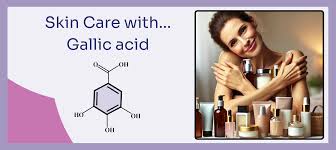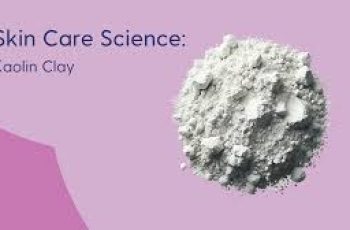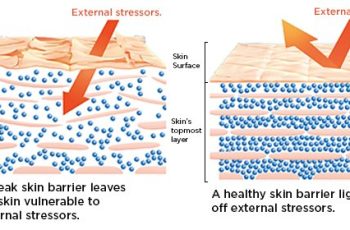Gallic acid In Skin Care
What is gallic acid?
Gallic acid (GA) is a naturally occurring phenolic compound found in various plants, including gallnuts, sumac, witch hazel, tea leaves, oak bark, and other plants. Diglucosyl gallic acid (DGA) is a biotechnologically modified form of gallic acid designed to be activated by the skin’s microbiome. These compounds have been shown to be effective and safe in cosmetic formulations. They are often found in skin lightening or antiaging serums and creams. These gallic acid compounds are known for potent antioxidant properties, which help in protecting the skin from oxidative stress and free radical damage. Additionally, gallic acid has anti-inflammatory properties which is why it is used to decrease dark spots from acne or melasma and to soothe sensitive skin.
As a Thank you for reading our educational content, we’d like to offer you 20% off your next purchase! At checkout, use the code STSBlog20 for an instant discount!
Stability: DGA is more stable and effective topically than gallic acid
Microbiome Activation: Unlike gallic acid, DGA is activated by the skin’s microbiome, converting into a potent tyrosinase inhibitor that lightens dark spots.
Good for Sensitive Skin: Soothing and calming properties
Melasma: Can be used in both treatment and maintenance regimens
Gallic acid Skin Care Products
Many top selling skin care brands are beginning to add gallic acid or diglucosyl gallic acid because of its effectiveness and tolerability. Here are some of my recommendations for products with DGA:
Diglucosyl Gallic Acid vs Gallic Acid
Gallic acid is a naturally occurring phenolic compound found in various plants, known for its antioxidant, anti-inflammatory, and antimicrobial properties. It protects the skin from free radicals, reduces inflammation, and helps combat microbial infections. However, while it is stable, it is susceptible to environmental factors and can degrade more quickly, potentially reducing its efficacy over time.
In skin care products, the derivative diglucosyl gallic acid may be used instead. Diglucosyl Gallic Acid is a biotechnologically created molecule in which gallic acid is linked with glucose molecules. This enhances its stability, making it more suitable for use in antiaging and skin lightening serums and creams. Diglucosyl gallic acid can inhibit tyrosinase after activation by the skin microbiome. This targeted activation allows a gradual activation process, which minimizes potential irritation and enhances tolerance. This is why this is a popular ingredient for skin lightening in sensitive skin types prone to reactivity.
What is Diglucosyl Gallic Acid?
Diglucosyl Gallic Acid (DGA) is the INCI name of a biotechnologically created molecule known for its skin-brightening, anti-inflammatory, and photoprotective properties. It is also referred to by the it’s other name Trihydroxy Benzoic Acid Alpha-Glucoside. This novel ingredient is activated by the skin’s microbiome, making it a unique addition to cosmetic formulations targeting hyperpigmentation and inflammation.
Benefits
This is an ingredient that is gaining popularity because of it’s benefits. The benefits of DGA for skin include:
Skin Brightening: Reduces the appearance of dark spots and promotes an even skin tone.
Anti-inflammatory: Decreases skin inflammation, which can reduce redness and swelling.
Photoprotection: Protects against UV rays by reducing UV-induced spot formation over time.
Antioxidant: Reduces free radical generation, protecting the skin from oxidative stress.
Anti-melanogenesis: Inhibits the production of melanin, preventing the formation of new dark spots.
Used To Treat
These soothing anti-inflammatory ingredients can be used to treat hyperpigmentation in sensitive skin types that may not be able to tolerate more irritating ingredients like hydroquinone.
Hyperpigmentation
Once applied to the skin, Diglucosyl Gallic Acid is partially converted by the skin microbiome into Trihydroxy Benzoic Acid. This conversion process results in two molecules that work synergistically:
Diglucosyl Gallic Acid: This molecule inhibits tyrosinase production, prevents melanin transfer to the upper skin layers, and controls skin inflammation.
Trihydroxy Benzoic Acid: A natural tyrosinase enzyme inhibitor that further reduces melanin synthesis.
Together, these molecules help control skin pigmentation by reducing melanin content, decreasing free radical generation, and modulating skin color to improve brightness and reduce redness, yellowness, and brownness.
Melasma
This is a good ingredient to use in your Melasma Maintenance Routine because it helps prevent inflammation and is only a mild tyrosinase inhibitor so it can be used in a tyrosinase inhibitor holiday.
Acne
This is a good ingredient in acne products if you have a skin type that develops dark spots from acne. This ingredient is noncomedogenic, sooths the redness of pimples, and helps lighten acne dark spots.
Safety
Both gallic acid and diglucosyl gallic acid are safe ingredients. They are rated a 1 by the EWG which is it’s safest rating. They can be used topically while breastfeeding and during pregnancy. This is why this ingredient is a popular melasma treatment to use during pregnancy.
DQH Knowledge drop: In your 20s, your skin cell turnover decreases. (Cell turnover is a key component in keeping your skin youthful.) You know what else slows down? Your collagen production. Starting in your 20s, collagen decreases by about 1 percent per year. Should you want to prevent fine lines and wrinkles, start by eliminating behaviors that contribute to premature aging. “If it’s bad for you, it’s bad for your skin,” says dermatologist Michel Somenek.
“Cigarette smoking reduces blood flow to the skin and causes premature wrinkling and a dull skin texture. Making the repeated pursed motion to inhale can also cause smoker’s lines. Alcohol and recreational drugs are toxins for the skin that damage its cellular structure and DNA,” Somenek tells us. “The faster you eliminate vices while you are young, the better chance your skin and body have to recuperate.” Also, adopting an anti-aging routine in your 20s is key. After all, the best offense is a good defense. We spoke to Somenek and experts Joshua Ross and Audrey Kunin to find out more.
Keep reading for the best anti-aging products for your 20s, according to skincare professionals.
Sunscreen
“We all know that the sun is the number one cause of skin aging and starting the prevention in your 20s is very important,” Ross says. “The majority of your sun damage won’t start to appear until you’re in your 30s, so don’t wait until you see it surface or you’ll be behind the curve. Stay ahead of it with a good-quality zinc-based sunscreen worn daily.”
Farmacy Green Defense Daily Mineral Sunscreen
An invisible sunscreen with SPF 30, plus botanical extracts meant to protect skin with tons of antioxidants. Bonus: It’s clean and fine to use under makeup.
Bareminerals Complexion Rescue™ Tinted Moisturizer Broad Spectrum SPF 30
Although we recommend you use your SPF and moisturizer separately, we also understand moments when you don’t have time or energy for that extra step. For those times, this bareMinerals moisturizer is a great thing to have on hand.
Vitamin C Serum
“A great introduction to anti-aging is to start with a vitamin C serum in your morning skincare routine,” Ross says. “It’s a powerful antioxidant that will neutralize free radicals and brighten the skin.” He adds that it’s a great way to counteract the effects of the sun’s harmful rays, which, as previously mentioned, are among the biggest causes of premature aging.
Drunk Elephant C-Firma™ Vitamin C Day Serum
The Drunk Elephant C-Firma is a lightweight serum that promises to give skin a glow by combining the brightening powers of vitamin C with ferulic acid, l-ascorbic acid, and vitamin E. The included sodium hyaluronate is meant to replace hydration loss, so you shouldn’t have to deal with any irritation.
Sunday Riley C.E.O. Rapid Flash Brightening Serum
This potent serum is jam-packed with vitamin C (15 percent, to be exact), which means it’s a potential superstar at both brightening skin and dousing it in antioxidants.
Peptides
Using peptides on your skin has many benefits, says Somenek. “The skin barrier is what defends the body against pollution, UV rays, bacteria, and toxins. It can be damaged by several everyday factors. Using topical peptides aids in building a stronger barrier,” he says. “Peptides comprise elastic fibers, which are a type of protein. These fibers help to make skin appear taut and firm. Peptides can also help repair damaged skin, relieve inflammation, and even out skin tone. Some peptides can kill acne-causing bacteria that is common in 20-somethings.”
Kunin agrees, saying, “Peptides are an excellent entry point for supporting collagen.” She recommends looking for face and eye treatments that contain these collagen-boosting powerhouses.
Charlotte Tilbury Magic Eye Rescue Cream
This Charlotte Tilbury super-emollient eye cream has a base of coconut oil and shea butter (read: it’s incredibly hydrating). Botanicals plus peptides are meant to help reduce dark circles and boost collagen, respectively.
This creamy moisturizer serves up potent collagen-boosting peptides and pycnogenol, and antioxidant-rich vitamin C. “Instead of sitting on top of the skin, peptides penetrate the outer layer so they go deep. The ‘signals’ they send tell the cells to produce elastin and collagen, which are needed for youthful-looking skin,” explains Somenek.
At-Home Peel Pads
Remember that skin cell turnover fiasco we talked about earlier? One way to help support it is by exfoliating. “Exfoliation is important to help keep skin fresh and luminous,” Kunin says. She recommends using at-home peel pads as an easy and effective way to exfoliate.
“The goal in your 20s is to fight the slowing pace of cell turnover. It is wise to use products that gently exfoliate, yet still remove oil and other impurities. Products that have Alpha Hydroxy Acids (AHA) or Beta Hydroxy Acids (BHA) are a good choice.”
According to Somenek, you should only exfoliate two to three times a week. “People of all ages are guilty of over-exfoliating and that can be too much of a good thing,” he says.
Dermadoctor Kakadu C Intensive Vitamin C Peel Pad
A few swipes of this Derma Doctor powerful peel pad promise to leave your skin glowing and smooth, thanks to the seven (yes, seven) types of chemical exfoliants, including AHA and BHA. It also contains vitamin C via Kakadu plum extract for added brightening and antioxidant protection.
KEY INGREDIENTS Kakadu plum extract is sourced from the Kakadu plum, a fruit grown in northern Australia. It contains vitamin C, which restores the skin’s natural barrier, increases collagen production, and soothes irritation.
Dr. Dennis Gross Skincare Alpha Beta® Universal Daily Peel Pads
These are the gold standard of peel pads, with a cult following and over 900 five-star reviews on Sephora. They’re easy to use and contain a blend of anti-aging exfoliating acids.
Emollient Night Cream
“In your 20s, you need to start upping the hydration in your skincare routine. You may have been cautious of over-moisturizing because of acne in your teens, but as you enter your 20s, your skin transitions and becomes drier,” Ross says. “I recommend an emollient night cream added into your evening skincare regimen.”
“Twenty-somethings need to make sure that they are not using creams that will clog their pores and cause excess oil production,” says Somenek. Opt for non-comedogenic products.
Cerave Skin Renewing Night Cream
One great choice is the CeraVe Skin Renewing Night Cream, which is a non-comedogenic night cream that leaves skin soft and glowy. It combines the moisturizing powers of ceramides and hyaluronic acid.
RoC Retinol Correxion Max Hydration Creme
“The best night cream ingredients contain retinol, benzoyl peroxide, and/or salicylic acid or hyaluronic acid. The goal is to moisturize, yet remove excess oil,” says Somenek. This Roc Retinol Correxion cream fits the bill as it contains both hyaluronic acid and retinol so it promises to moisturize while also being non-comedogenic.



